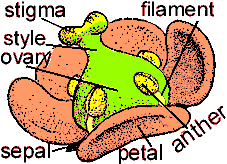
ANTHER + FILAMENT = STAMEN (male part)
STIGMA + STYLE + OVARY = PISTIL (female)
SEPALS ARE LOBES OF THE CALYX
PETALS ARE PARTS OF THE COROLLA
Blossoms come in such a bewildering variety of shapes, sizes, and arrangements that to keep from getting befuddled it helps to keep in mind a single, simple concept to which all the world's real flowers can be related. Our single, simple concept is the Standard Blossom, the flower diagrammed at the right. The Standard Blossom is nothing less than the most average, unspecialized, simple, and downright boring blossom imaginable. The value of the Standard Blossom is this:
Whenever we meet a flower that in some way differs from the Standard Blossom -- and every flower we meet will differ in at least some tiny way -- then we'll know that that difference is part of what makes our new flower special...

The hibiscus flower at the right obviously is very different from the Standard Blossom. However, it's typical of what flowers in "real life" are like. That is, at first glance it's profoundly different from the Standard Blossom, yet it is composed of basic parts that fundamentally are the same as in our Standard Blossom. The hibiscus flower has stamens, but instead of five, it has many. Instead of its many stamens issuing from the base of the ovary, as in the Standard Blossom, the hibiscus stamens' filaments unite at their bases to form a tube, the staminal column, surrounding the flower's long style. The staminal column is something completely missing in our Standard Blossom, so we know it's something special to be looked for in hibiscus flower. In the world of flowers, we're constantly surprised by such unexpected innovations.
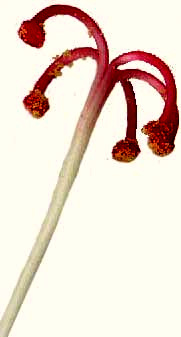
At the left, the hibiscus flower's style has been removed from inside the staminal column. Notice that it is long and slender, instead of short and thick, as in our Standard Blossom. Also, the style splits at the top, forming five branches, each of which ends with a knobby stigma. Beyond all that, the hibiscus corolla has shallow lobes, while the Standard Blossom's corolla consists of separate petals. We have a special hibiscus-flower page showing other interesting features of hibiscus flowers.
The blossom has protective parts
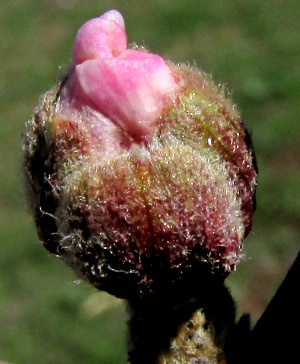
At the right, a peach-tree blossom is just beginning to open, in early spring. During the winter, the developing flower has been protected by bud scales completely surrounding it. Now as the flower begins to unfurl, its hairy sepals -- which later will reside mostly hidden beneath the corolla grown above it -- continue protecting the inner parts against hungry insects, temperature extremes, drying out, sunburn, and physical knocks.
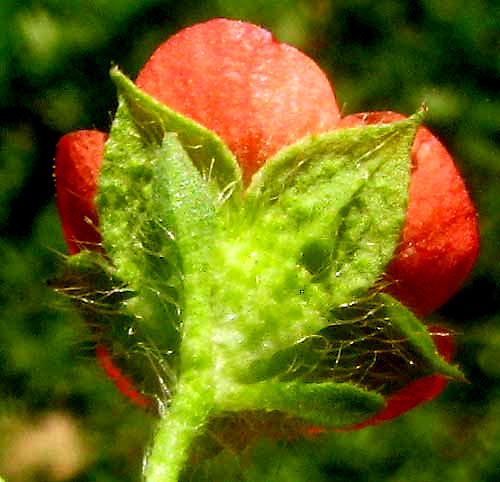
Once the flower is completely open, the hairy sepals will resemble a little green cup with five or so lobes, called the calyx. At the left you see a fully developed flower of the Bristlemallow, Modiola caroliniana, also with a reddish corolla and green sepals, but the bristlemallow's sepals are sharp-pointed, not rounded like those of the peach.
The blossom has animal-attracting parts
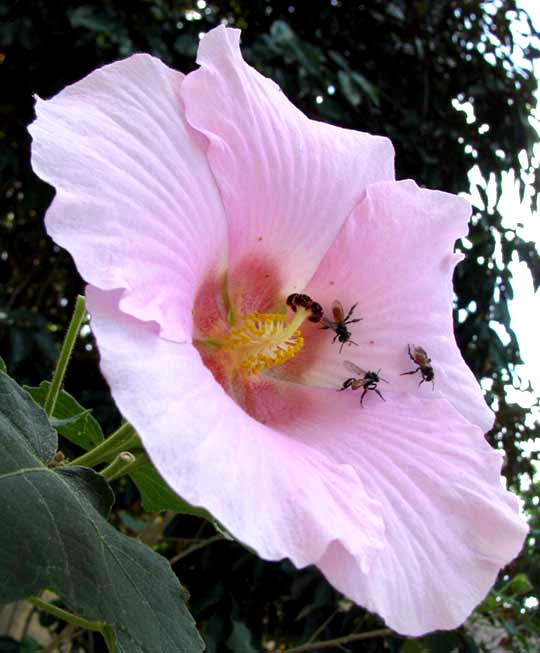
The most eye-catching flowers usually are those who must attract animals, especially insects, to pollinate them. In most cases the part of the flower visually catching the animal's attention is its relatively large, colorful corolla. Often corollas consist of separate parts referred to as petals. Other times corolla parts are joined together like teeth on a crown, and can be called corolla lobes. Our Standard Blossom's corolla is divided into five distinct petals, same as the Cotton Rosemallow, Hibiscus mutabilis, shown at the right.
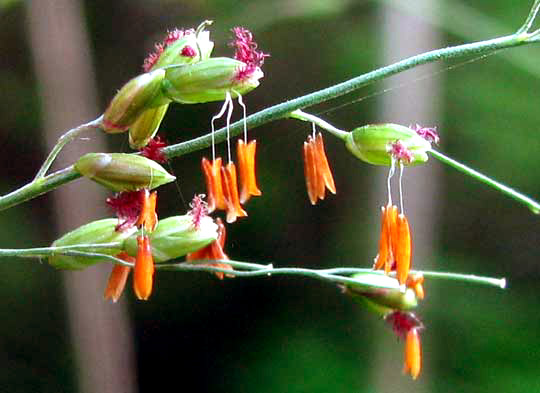
Many flowers, such as Guinea Grass, Panicum maximum, shown at the left, have no need for animal-attracting parts. About 12% of the world's flowering plants are wind-pollinated. That includes all grasses, as well as about 98% of all gymnosperms, including pines, spruces and firs. This is worth thinking about in a world in which ever greater numbers of pollinators are threatened with extinction.
The blossom has male sexual parts
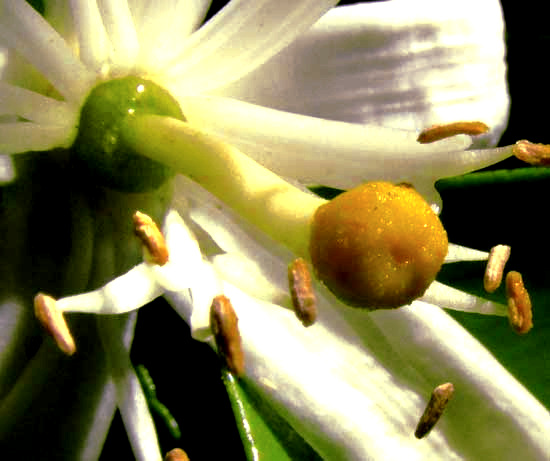
About 90% of all flowering species produce flowers bearing both male and female parts, as does our Standard Blossom, and Bitter Orange, Citrus aurantium, of which a close-up of the blossom center appears at the right.
In that photo, the male parts, the stamens, are the numerous match-stick-like items, composed of slender, white, stem-like filaments and tiny, banana-shaped, pollen-producing anthers. The stamens radiate outwards from the base of the female parts.
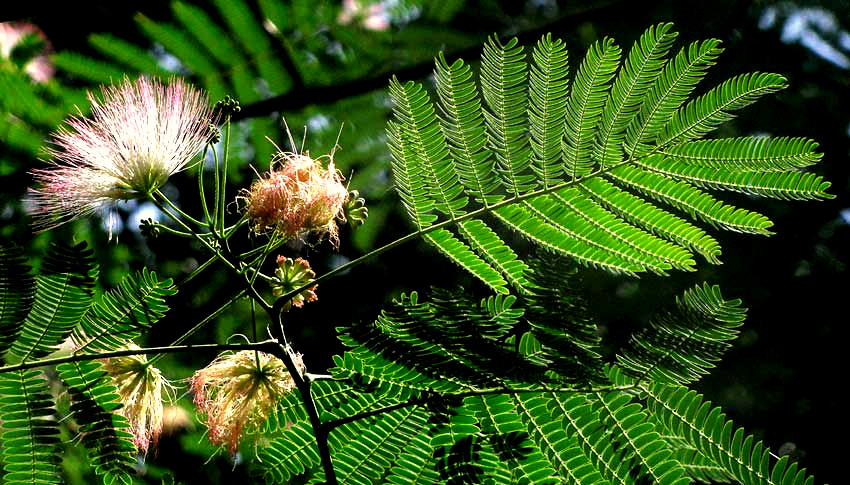
In some flowers, the stamens put on a show. At the left, stamens of the much-cultivated Silk tree, Albizia julibrissin, project far beyond the female parts of numerous small, inconspicuous flowers clustering in a spherical head.
When stamens are sexually mature, their anthers split open and release yellow, dust-like particles; that "dust" is pollen. A pollen grain consists of three microscopic cells: a vegetative cell enclosing two sperm cells. When a pollen grand lands on a flower's stigma, the grain's vegetative cell forms a “pollen tube” that grows down through the whole style and ovary, until it comes to an ovule, where the two sperm enter into the ovule, and fertilization takes place. Once that happens, the flower's male parts no longer are needed. Typically, the stamens shrivel, dry up and fall away as the female part starts growing, ultimately maturing into a fruit bearing seeds.
The blossom has female sexual parts

At the left, the white object is a garden tulip's female part, the pistil. The white pistil is surrounded by six slender, black stamens. Pistils normally are composed of three main parts: stigma, style and ovary. In the picture, the pistil's three-lobed top is the stigma, where pollen is deposited and germinates. The "neck area" between the stigma and the thick part below it called the style, and the thick lower part below the style is the ovary. Inside the ovary reside tiny ovules, which eventually will mature into seeds.
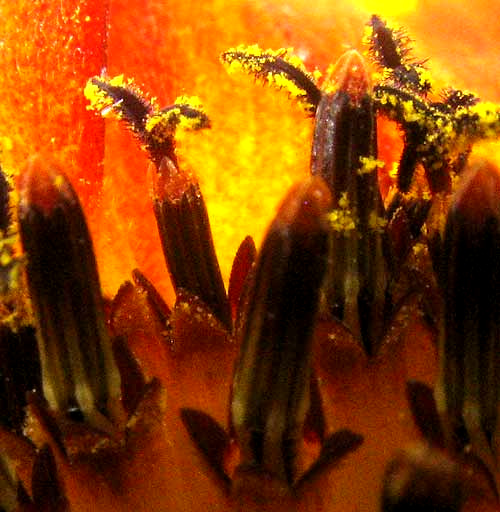
In some flowers the style is absent, the stigma attaching directly to the ovary. In others, the style branches into two or more parts which bear a small stigma at each branch tip. Sometimes, as in the huge Aster or Composite Family, styles split into branches bearing no obvious stigmas, but which are covered with hair-like "stigmatic papillae." At the right, yellow pollen grains adhere to curving style branches fuzzy with hairlike stigmatic papillae. This is a close-up of disc florets in the eye of an ornamental Sunflower, Helianthus annuus.
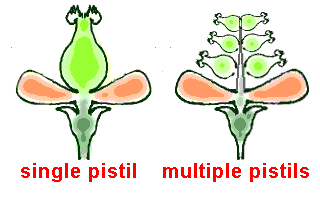
With regard to pistils, flowers are divided into two great groups: Those with a single pistil, and those with more than one. The diagram at the left illustrates the two strategies. The tulip and most flowers bear just one pistil. However, the blossoms of many important kinds of plants have more than one -- such as buttercups, roses and magnolias.
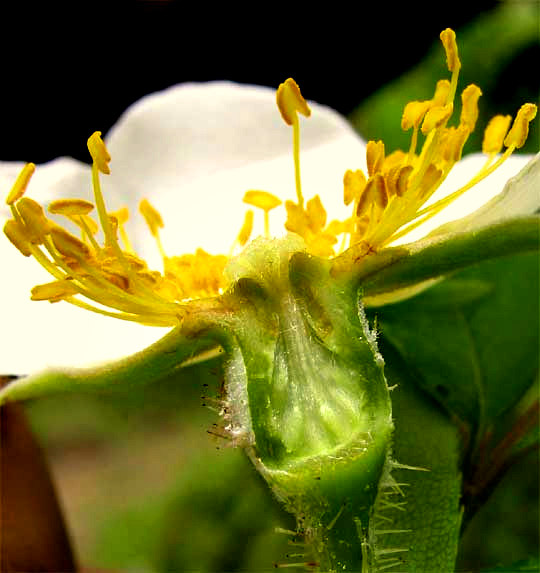
At the right you see a flower of a wild Cherokee Rose, Rosa laevigata, with one side of the green part below the petals removed, revealing multiple pistils arising from the bottom of the blossom's interior.
Inferior or superior ovary?
When you learn to identify plants, nothing is more important than flower structure, and one of the very first questions you will learn to ask yourself when presented with an unknown flower will be "Does it have an inferior or superior ovary?" The two options are diagrammed below.
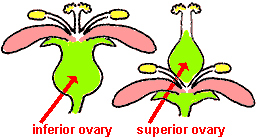
Our Standard Blossom atop this page, like most flowers you'll meet in your life, has a superior ovary, right? Though superior ovaries are the most common kind, species in many familiar plant families have inferior ones. Members of the Iris, Honeysuckle, Squash and the huge Sunflower Families have flowers with inferior ovaries. Below you see a squash flower's inferior ovary, the corolla on the left, the ovary on the right:

The inferior ovary in that picture will become a Yellow Crookneck squash. In accordance with our above diagram of inferior and supior ovaries, the squash flower's ovary is inferior because sepals (the calyx) and corolla arise at the ovary's top, not at its base where it attaches to the green stem or pedicel.